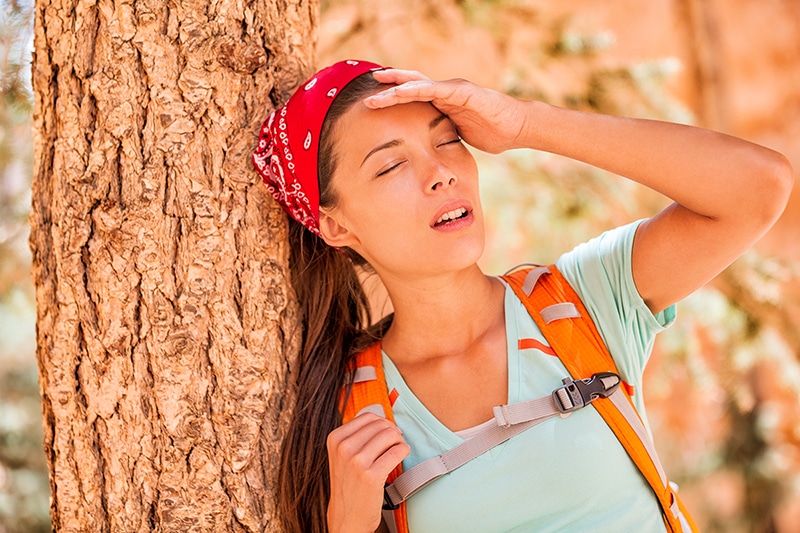This post contains affiliate links. I may earn a small commission at no extra cost to you. Learn more.
How to Spot Heat Exhaustion in the Wild — and Act Before It’s Too Late
How to spot heat exhaustion in the wild isn’t just good knowledge—it’s survival intelligence. When temperatures soar and your body starts to fail, recognizing the signs early can mean the difference between a quick recovery and a medical emergency. Out in the backcountry, miles from help, knowing what to look for could literally save your life.
🌡️ Related: Stay Cool Camping Tips: Beat the Heat Like a Pro
Extreme Heat—America’s Stealth Wilderness Killer
News feeds love dramatic hazards—flash floods roaring through canyons, bears charging startled campers, lightning spearing alpine ridges—but none of those headlines match the quiet body count of heat. The Centers for Disease Control and Prevention estimates that extreme heat claims well over seven‑hundred American lives every year, a toll that routinely outpaces hurricanes, tornadoes, and winter storms combined.
The problem is getting worse. During the 2023 warm season, emergency departments recorded a sharp spike in heat‑illness visits among adults 18–64—the age bracket that fills most trail registers. National‑park data echo the trend: in Texas’s Big Bend, hyperthermia has overtaken falls and heart attacks as the #1 cause of visitor deaths.
Heat doesn’t pounce like a flash flood; it whispers. First you see a salt crust on your hat, then a lag in your stride, then a half‑second delay answering a partner. Ignore those signals and you slide across an invisible line: core temperature creeps past 100 °F, electrolytes thin out, blood pressure sags, and at 104 °F the brain misfires.
This guide stops that slide. You’ll learn how your body dissipates heat, the one‑minute field test that exposes trouble early, a two‑week acclimatization plan that expands plasma volume, and cooling tactics that pull a victim back from the brink when evacuation is hours away. Master these skills and heat becomes one more variable you manage—like mileage, food, or map bearings.
1. Heat Illness 101 — A Sliding Scale, Not Three Boxes
| Level | Core Temp (rectal) | Key Symptoms | Field Fate if Ignored |
|---|---|---|---|
| Heat cramps | Normal–100 °F | Calf/quad spasms, heavy sweat | Performance drop; signals sodium loss |
| Heat exhaustion | 100–104 °F | Dizziness, nausea, pulse > 100 bpm, cool clammy skin, weak gait | Progresses to stroke in ≤ 60 min |
| Heat stroke | > 104 °F | Confusion, aggression, seizures; skin may be wet or dry | 20–70 % mortality unless cooled < 102 °F within 30 min |
Myth‑buster: exertional heat‑stroke victims often still sweat, so “dry skin” is not reliable.
2. The Physiology Behind Heat Exhaustion
Thermoregulation equation: metabolic heat + ambient/radiant load must be ≤ evap + convective cooling. When the left side wins, core temperature rises.
As sweat drains plasma, blood pressure dips and brain perfusion falls. At about 2 % body‑mass loss you make navigation mistakes; at 4 % you enter heat‑exhaustion territory; beyond 5 % or 104 °F, organs begin to cook.
3. Early‑Warning Toolkit
60‑second trail test (run hourly):
- Pulse 15 s × 4 > 100 bpm = red flag.
- Talk + math: ask “17 × 4?” Slow answer = brain hypoperfusion.
- Capillary refill > 2 s.
- Salt streaks on hat/backpack straps.
- No urine in 6 h or dark amber color.
Memory hook – C L A M M Y: Cool skin, Light‑headed, Accelerated pulse, Muscle cramps, Maybe nausea, Yawning fatigue. Two or more? Stop and cool.
4. Heat Exhaustion vs. Heat Stroke — Zero‑Confusion Matrix
| Marker | Exhaustion | Stroke | Why It Matters |
|---|---|---|---|
| Mental status | Lucid but weak | Disoriented / combative / seizures | Brain temp > 40 °C cripples neurons |
| Rectal temp | 100–104 °F | > 104 °F | Only rectal accurate in wind/humidity |
| Sweat | Profuse | Variable (may still sweat) | Dry‑skin myth kills |
| Cooling window | 30–60 min | < 30 min | Survival hinges on < 102 °F by half‑hour |
Decision rule: any mental alteration → treat as stroke, cool aggressively, arrange evac.
5. Water, Salt, and the Hyponatremia Trap
Every drop of sweat you lose carries roughly 900 mg of sodium, 200 mg of potassium, and trace chloride. If you replace that loss with nothing but plain water, you dilute blood sodium and risk dilutional hyponatremia—confusion, vomiting, even seizures that can masquerade as heat stroke. Aim for 0.5–0.7 g sodium per litre of intake, plus a little fast carbohydrate to speed absorption via the sodium–glucose co‑transporter.
DIY Electrolyte Mix (1 L)
- ⅛ tsp table salt ≈ 750 mg sodium
- ⅛ tsp Lite‑Salt (50 % KCl) ≈ 175 mg potassium
- 1 Tbsp white sugar or honey (15 g quick carbs)
- Squeeze of True Lime or lemon for flavour
- (Optional) 2 drops iodine tincture if you adventure in a goitre‑belt region
Store‑Bought vs DIY—Quick Compare
| Option | Sodium | Potassium | Carbs | Best Use‑Case |
|---|---|---|---|---|
| DIY mix above | ~750 mg | ~175 mg | 15 g | Budget, heavy sweaters, flexible flavour |
| LMNT Raw Stick | 1 000 mg | 2 mg | 0 g | Keto / low‑carb athletes, desert hikes |
| Nuun Sport Tab | 300 mg | 150 mg | 4 g | Moderate heat, light sweaters |
| Skratch Hydration | 380 mg | 40 mg | 20 g | Endurance efforts needing fuel + lytes |
Bottom line: plain water is not enough. Keep both water‑only and electrolyte bottles — labelled “W” and “E” on the cap — and alternate sips to maintain balance.
6. Two‑Week Heat‑Acclimatization Program
Two‑Week Heat‑Acclimatization Program
Seven to fourteen days of controlled heat exposure raises plasma volume 8–10 % and doubles sweat rate. Sample schedule:
- Days 1‑2: 20 min walk at 90 °F, 60 % HRmax.
- Days 3‑4: 30 min incline treadmill, 92 °F.
- Days 5‑6: 40 min with 10‑lb pack, 95 °F.
- Days 7‑10: Outdoor mid‑day hikes, 60 min, 95–100 °F.
- Days 11‑14: Simulate trip pace & pack at 90‑105 °F.
7. Environmental Multipliers — Desert vs. Jungle (and Beyond)
Desert tips: a reflective trekking umbrella knocks 8–12 °F off scalp temps; a wet‑cotton bandana becomes an evaporative cooler when relative humidity < 30 %; plan a strict siesta from 11 a.m. to 4 p.m.
Jungle tips: in 85 % humidity, evaporation stalls, so mesh synthetics beat cotton; pre‑load salt tabs every 45 min; machete a mini breezeway at rest stops to create convection.
High‑Altitude Tropics (cloud forests, volcano treks): solar radiation is intense but ambient temps can crash 30 °F after a thunderstorm. Pack both a reflective sun layer and an ultra‑light puffy — hypothermia often ambushes right after severe heat stress when sweat‑soaked clothes meet cold rain.
8. Gear & Tech That Actually Shift Core Temperature
| Category | Top Pick | Why It Works | |
|---|---|---|---|
| WBGT Meter | Kestrel 5400 Heat‑Stress Tracker | Calculates real‑time wet‑bulb globe temp and alarms when conditions hit danger zone. | Buy Now |
| Reflective Trekking Umbrella | Six Moon Designs Silver Shadow | Cuts radiant load on head/neck by ~10 °F; doubles as rain cover. | Buy Now |
| Cooling Sleeves | SportsTrail Arm Sleeves | Wet fabric over radial arteries acts as an active radiator in low‑humidity zones. | Buy Now |
| Pack Ventilation | Osprey Exos 58 | Trampoline mesh back panel keeps 1‑inch airflow gap, lowering back skin temp ~10 %. | Buy Now |
| Hydration Filter Bottle | Instant filtration so you never ration water—drink to thirst, not to supply. | Buy Now | |
| Rapid Electrolytes | LMNT Raw Sticks | 1 000 mg sodium per stick—stops hyponatremia on heavy‑sweat days. | Buy Now |
As an Amazon Associate, The Savvy Survivalist earns from qualifying purchases.
9. Treatment Protocol — Cool First, Transport Second
- Move victim to shade or create it.
- Lay supine, elevate legs 6–8 in.
- Strip or loosen clothing; protect from sun.
- Active cooling: douse with water & fan, immerse forearms, ice to neck/groin/armpits.
- Oral rehydration if alert: 200 ml electrolyte every 5 min.
- Re‑check vitals every 5 min; log times.
- Evacuate if core > 102 °F after 30 min cooling or mental status deteriorates.
10. Special Populations
Children: higher surface‑area‑to‑mass; cool faster AND heat faster. Offer flavored electrolyte ice pops.
Seniors: diminished thirst and sweat output; continuous temp sensors help.
Dogs: panting fails in humidity; bright‑red gums and wobbling gait signal imminent heat stroke—douse and rest.
11. Real‑World Case Studies
Grand Canyon Rim‑to‑Rim (May 2022): Runner collapsed mid‑canyon with rectal temp 103.2 °F; creek immersion dropped core to 101.8 °F in 25 min—stroke averted.
Amazon Basin Bio‑Survey (Aug 2023): Scientist collapsed at 104.6 °F but still sweating; mist‑and‑fan hut plus high‑sodium ORS lowered temp to 102 °F in 37 min—evac by boat.
12. Myth‑Buster Deep Cuts
- “Energy drinks hydrate.” ➜ High sugar & caffeine slow gastric emptying—dilute 50/50 and add salt.
- “Pour water on head to cool.” ➜ Skull dissipates little heat—drench torso/limbs instead.
- “Cotton kills everywhere.” ➜ In arid heat, wet cotton becomes an evaporative cooler.
13. Cheat‑Sheet — SACD + SALT
S Stop · Shade · Sit — A Assess vitals & talk test — C Cool with water/fan/ice — D Decide monitor vs. evacuate — SALT Sip Accurate Lyte Tonic (0.5–0.7 g Na/L)
Once you know the warning signs, reinforce your defenses with a DIY Cooling Neckwrap and the best hydration packs for hot weather to stay safe in the field.
Conclusion: Turning Heat from Threat into Known Variable
Heat illness is a predictable cascade: dehydration shrinks plasma, the heart strains to cool the skin, core temperature climbs, and organs begin to fail. Each step offers a chance to act—if you notice the signs. Feel rubbery legs on an easy grade, count a resting pulse that shouldn’t be racing, note urine darkening to amber, and run the sixty‑second self‑check before warning lights multiply.
Preparation matters as much as awareness. Two deliberate weeks of heat exposure can boost plasma volume nearly ten percent, priming sweat glands to fire earlier with less salt loss. Pair that internal upgrade with smart external gear—mesh‑back packs, reflective umbrellas, or a splash‑and‑fan “poor‑man’s ice bath”—and the odds of even reaching heat‑exhaustion territory plummet.
If a teammate still tips over the edge, remember the prime directive: cool first, move later. Shade, douse, fan, and ice until core temperature falls below 102 °F; then evacuate while continuing active cooling. Too many patients stabilize on scene only to rebound in a sweltering vehicle.
Print the SACD + SALT checklist for every first‑aid kit, share this guide with the buddy who thinks plain water is enough on a hundred‑degree day, and bookmark our Ultimate Water Purification and DIY Bug‑Repellent guides for a fully fortified summer kit. Recognize heat’s first whispers, respect its power, and you will finish every hot‑weather adventure on your own feet—cool head, steady pulse, and one more story for the trail log.







